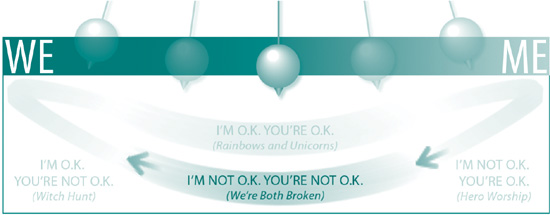

When the Pendulum has reached a twenty-year Zenith and fallen halfway back to the fulcrum, Alpha Voices emerge in technology and literature, giving us an early glimpse of the new values that will become mainstream in just ten years. These Alpha Voices never realize their own significance at the time; only later do they see that they were the prophets of what was to come.
Everyone in society is aware of these Alpha Voices, though they don’t yet know if the Alphas will be a fad or a trend. We discuss them, argue about them, debate their message, and wrestle with their appropriateness. This continues until year thirty-five, when a new, fringe genre of music joins the Alpha Voices, one that gains momentum day by day, accelerating the new values’ acceptance that will soon explode into widespread acceptance in the year of the tipping point.
When the tipping point at the fulcrum is finally reached and the Pendulum begins a new twenty-year upward climb, the sun shines more brightly, the birds sing more sweetly, and everyone grows excited as life itself is reinvented. Magic sparkles in the air.

PhotoDune / Solarseven
The new values that the Alpha Voices of technology and literature had hinted at ten years earlier now gain widespread acceptance. This tipping point marks the beginning of that highly predictable, six-year transitionary window in which the majority of society will adopt the new values.
The year 1963 was the tipping point year from a “We” perspective back into the “Me.” The people who lived through those years will tell you that 1960 through 1962 weren’t really part of the magic called “The ’60s”—those years were just the tail end of the ’50s.
Look closely and you’ll see that all the magic of “the ’60s” happened from 1963 to 1968. This was the six-year transitionary window.
Figure 5.1 Alphas are leaders who herald the changing mindset after a “ME” and “WE” Zenith.
| ROLE OF ALPHAS | |
| THE MAGIC OF THE TRANSITIONARY WINDOWS | |
| WHO: | Authors, artists, and thought leaders |
| WHAT: | Technology |
| WHEN: | Literature and technology—ten years after a Zenith Music—fifteen years after a Zenith |
| WHY: | Restore balance |
The next tipping point, from “Me” back into “We,” occurred in 2003. We’ll examine both of these tipping points in detail in later chapters, but right now the only thing that matters is that you understand that 2003 to 2008 was another magical six-year window, although most of us didn’t realize it at the time. The further we move away from those years, however, the more we’ll recall the magic, the discovery, and the wonder of those sunlit days.
Let’s look at those six years. Prior to 2003, the secure transfer of money online was a problem. Uploading a video was an even bigger problem. Search engines were an exercise in frustration.
Figure 5.2 The Tipping Point from “ME” to “WE.”


iStockphoto / nazdravie
Although Google was incorporated in 1998, those first five years were all about finding focus, struggling with the business model, and wrestling with challengers. In 2003, Google moved into their current location, “The Googleplex” at 1600 Amphitheatre Parkway in Mountain View, California, “to organize the world’s information and make it universally accessible and useful.”
PayPal™ was purchased by eBay® in October, 2002. In early 2003, PayPal then whooshed into popularity, making e-commerce possible for even the smallest of websites.
Facebook was launched in February, 2004 “to give people the power to share and make the world more open and connected.”
Three former PayPal employees created YouTube in February, 2005 “to provide fast and easy video access and the ability to share videos frequently.”
Twitter was launched in July, 2006 “to instantly connect people everywhere to what’s most important to them.”

iStockphoto / Alija
Jimmy Wales launched Wikipedia in 2001. In 2003, it exploded into such a phenomenon that in 2006 Time magazine named him one of the world’s most influential people.
As we’ve discussed, birth cohorts don’t define a generation; instead, a generation is composed of all the people alive in a society simultaneously—life cohorts.
So do birth cohorts share a common denominator other than an age bracket?
Yes, they most certainly do. Birth cohorts share a specific window of opportunity upon their coming-of-age. Malcolm Gladwell makes this point quite powerfully in his book Outliers: The Story of Success showing the names and fortunes of the seventy-five wealthiest people in the history of the world calculated in current US dollars. An astounding fourteen of these seventy-five billionaires were Americans born in a nine-year window centered in 1835.
This was when the railroads were being built and when Wall Street emerged. It was when industrial manufacturing started in earnest. It was when all the rules by which the traditional economy had functioned were broken and remade. . . . If you were born in the late 1840s you missed it. You were too young to take advantage of that moment. If you were born in the 1820s, you were too old: your mind-set was shaped by the pre–Civil War paradigm. But there was a particular, narrow nine-year window that was just perfect for seeing the potential that the future held. 1

iStockphoto / Daft_Lion_Studio
Thus, your birth year does not determine your attitudes and beliefs, but it does determine your opportunities. History has proven this again and again.